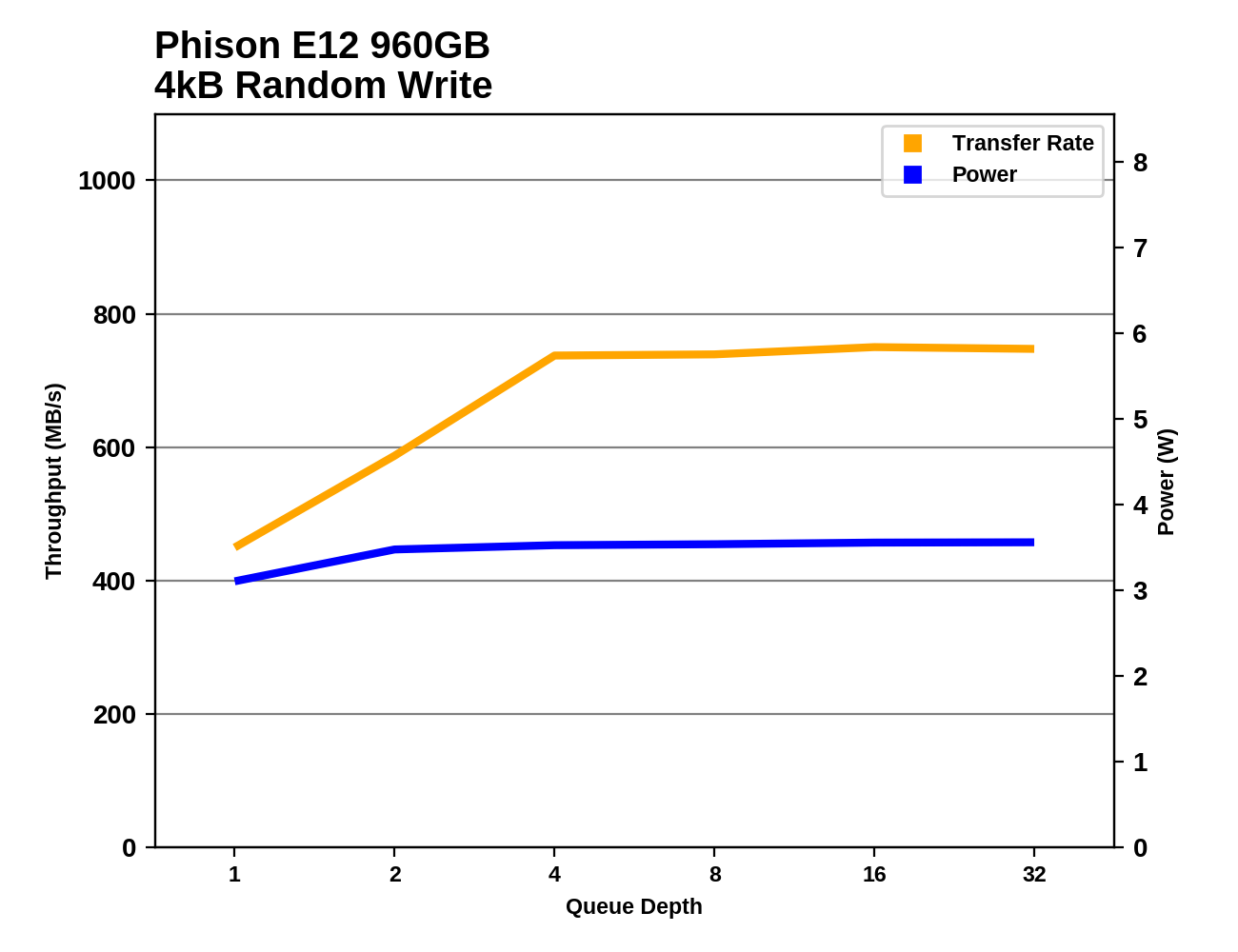The Phison E12 Reference Design Preview: A Next-Gen NVMe SSD Controller
by Billy Tallis on July 18, 2018 10:30 AM ESTRandom Read Performance
Our first test of random read performance uses very short bursts of operations issued one at a time with no queuing. The drives are given enough idle time between bursts to yield an overall duty cycle of 20%, so thermal throttling is impossible. Each burst consists of a total of 32MB of 4kB random reads, from a 16GB span of the disk. The total data read is 1GB.

The burst random read speed of the Phison E12 is very good, but the HP EX920 still stands out as the leading flash-based SSD on this test.
Our sustained random read performance is similar to the random read test from our 2015 test suite: queue depths from 1 to 32 are tested, and the average performance and power efficiency across QD1, QD2 and QD4 are reported as the primary scores. Each queue depth is tested for one minute or 32GB of data transferred, whichever is shorter. After each queue depth is tested, the drive is given up to one minute to cool off so that the higher queue depths are unlikely to be affected by accumulated heat build-up. The individual read operations are again 4kB, and cover a 64GB span of the drive.

On the longer random read test where some higher queue depths come into play, the Phison E12's performance is a bit below par as several other TLC-based SSDs are a bit faster, even those using the same BiCS3 3D TLC.
 |
|||||||||
| Power Efficiency in MB/s/W | Average Power in W | ||||||||
The power efficiency of the Phison E12 during the sustained random read test is decent, and the overall power consumption is only a bit higher than the Phison E8-based Kingston A1000. The only TLC SSD that's both faster and more efficient than the Phison E12 is the WD Black, which just barely faster.
 |
|||||||||
The random read speed of the Phison E12 scales up nicely as queue depths increase, and the power consumption doesn't get out of hand. By QD32 a few TLC drives are a bit ahead of the Phison E12, but the only big performance gaps are relative to the MLC SSDs and the Intel Optane SSD.
Random Write Performance
Our test of random write burst performance is structured similarly to the random read burst test, but each burst is only 4MB and the total test length is 128MB. The 4kB random write operations are distributed over a 16GB span of the drive, and the operations are issued one at a time with no queuing.

The Phison E12 sets a new record for burst random write performance, improving slightly over the WD Black that formerly held a wide lead.
As with the sustained random read test, our sustained 4kB random write test runs for up to one minute or 32GB per queue depth, covering a 64GB span of the drive and giving the drive up to 1 minute of idle time between queue depths to allow for write caches to be flushed and for the drive to cool down.

On the longer random write test, the Phison E12 is in a multi-way tie for second place, slightly behind the WD Black.
 |
|||||||||
| Power Efficiency in MB/s/W | Average Power in W | ||||||||
The Phison E12 matches the Samsung 970 EVO for power efficiency on the sustained random write test. The WD Black and Toshiba XG5 both have significantly better power efficiency with the same NAND. The WD Black is faster while drawing a bit less power, while the XG5 is significantly slower but also much less power-hungry.
 |
|||||||||
Even though quite a few drives turned in very similar performance scores for the average of QD1-QD4, the actual performance scaling curves vary quite a bit. The Phison E12's random write performance is very good at QD1 and QD2, but at higher queue depths many drives overtake it and saturate at a much higher speed.










28 Comments
View All Comments
DigitalFreak - Wednesday, July 18, 2018 - link
Another high end competitor is always a welcome site. Hopefully it will push prices down further.Mikewind Dale - Wednesday, July 18, 2018 - link
And that idle power consumption is great. Looks like we have a great SSD for laptops.Amoro - Wednesday, July 18, 2018 - link
Wonder why they didn't use DDR4L?FATCamaro - Wednesday, July 18, 2018 - link
All DDR4 is the same. There are only improvements in LPDDR4 which I haven’t seen anywhere yetIII-V - Wednesday, July 18, 2018 - link
DDR4L operates at a lower voltage, and consumes 80% of the power of DDR4. Where LPDDR shines is with standby power, which is far lower than DDR4 and DDR4L.bug77 - Wednesday, July 18, 2018 - link
For laptops, SATA will always be the less power hungry choice.Death666Angel - Thursday, July 19, 2018 - link
If you can do more tasks in the same amount of time, I think a lot of people will not mind a fractional increase in power consumption. How much of a fraction is the SSD power consumption on modern laptops anyway? LCD should still be #1 over the course of a full battery charge.bug77 - Thursday, July 19, 2018 - link
It's about idle power. It's higher on PCIe.And you can rarely get more things done on a NVMe drive, 4k random reads are only slightly better than AHCI. And 4k random reads is what you do most of the time ;)
Lolimaster - Thursday, July 19, 2018 - link
And unless you want a desktop replacement laptop nvme makes very little sense for 95% of the users (5% being 4k video editiors).bug77 - Friday, July 20, 2018 - link
There could be that some laptops only have M2 slots for expansion?